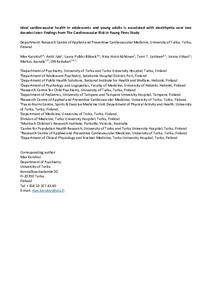Ideal cardiovascular health in adolescents and young adults is associated with alexithymia over two decades later: Findings from the cardiovascular risk in Young Finns Study
Viikari J; Laitinen TT; Karukivi M; Jula A; Hutri-Kähönen N; Pulkki-Råback L; Raitakari O; Juonala M
Ideal cardiovascular health in adolescents and young adults is associated with alexithymia over two decades later: Findings from the cardiovascular risk in Young Finns Study
Viikari J
Laitinen TT
Karukivi M
Jula A
Hutri-Kähönen N
Pulkki-Råback L
Raitakari O
Juonala M
Julkaisun pysyvä osoite on:
https://urn.fi/URN:NBN:fi-fe2021042825432
https://urn.fi/URN:NBN:fi-fe2021042825432
Tiivistelmä
We evaluated the association of cardiovascular health in adolescence and young adulthood with alexithymia 25 years later. The study sample (n = 1122) participated in evaluations conducted in 1986 (baseline) and in 2011-2012 (T2). Baseline health factors and behaviors were assessed utilizing seven ideal cardiovascular health metrics (ICH index) including blood pressure, cholesterol and glucose levels, smoking, physical activity, body-mass-index, and diet. The stability of the ICH index was evaluated with corresponding assessments in 2007 (T1). At T2, alexithymia was measured with the 20-item Toronto Alexithymia Scale (TAS-20). The main analyses were conducted using ANCOVA and adjusted for depression, age, and present social and lifestyle factors. TAS-20 subscales, Difficulty Identifying Feelings (DIF), Difficulty Describing Feelings (DDF), and Externally Oriented Thinking, were analyzed separately. The ICH index was significantly associated with the TAS-20 total score, as well as both with DIF and DDF. A less ideal cardiovascular health was associated with higher alexithymia scores. However, regarding the separate factors, only the association between non-ideal dietary habits and DIF was significant in the multivariate analyses. The baseline ICH index score was stable from baseline to T1. We conclude that non-ideal cardiovascular lifestyle habits in adolescence and young adulthood are significantly associated with later alexithymia.
Kokoelmat
- Rinnakkaistallenteet [19207]
